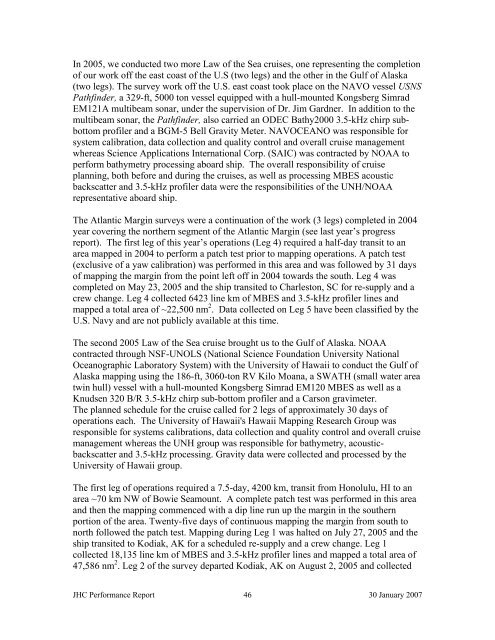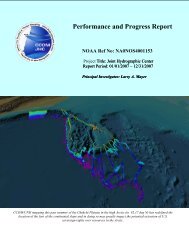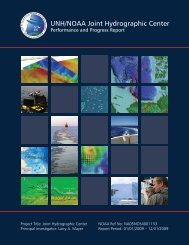Performance and Progress Report - John Doe FIX: put in the authors ...
Performance and Progress Report - John Doe FIX: put in the authors ...
Performance and Progress Report - John Doe FIX: put in the authors ...
You also want an ePaper? Increase the reach of your titles
YUMPU automatically turns print PDFs into web optimized ePapers that Google loves.
In 2005, we conducted two more Law of <strong>the</strong> Sea cruises, one represent<strong>in</strong>g <strong>the</strong> completion<br />
of our work off <strong>the</strong> east coast of <strong>the</strong> U.S (two legs) <strong>and</strong> <strong>the</strong> o<strong>the</strong>r <strong>in</strong> <strong>the</strong> Gulf of Alaska<br />
(two legs). The survey work off <strong>the</strong> U.S. east coast took place on <strong>the</strong> NAVO vessel USNS<br />
Pathf<strong>in</strong>der, a 329-ft, 5000 ton vessel equipped with a hull-mounted Kongsberg Simrad<br />
EM121A multibeam sonar, under <strong>the</strong> supervision of Dr. Jim Gardner. In addition to <strong>the</strong><br />
multibeam sonar, <strong>the</strong> Pathf<strong>in</strong>der, also carried an ODEC Bathy2000 3.5-kHz chirp subbottom<br />
profiler <strong>and</strong> a BGM-5 Bell Gravity Meter. NAVOCEANO was responsible for<br />
system calibration, data collection <strong>and</strong> quality control <strong>and</strong> overall cruise management<br />
whereas Science Applications International Corp. (SAIC) was contracted by NOAA to<br />
perform bathymetry process<strong>in</strong>g aboard ship. The overall responsibility of cruise<br />
plann<strong>in</strong>g, both before <strong>and</strong> dur<strong>in</strong>g <strong>the</strong> cruises, as well as process<strong>in</strong>g MBES acoustic<br />
backscatter <strong>and</strong> 3.5-kHz profiler data were <strong>the</strong> responsibilities of <strong>the</strong> UNH/NOAA<br />
representative aboard ship.<br />
The Atlantic Marg<strong>in</strong> surveys were a cont<strong>in</strong>uation of <strong>the</strong> work (3 legs) completed <strong>in</strong> 2004<br />
year cover<strong>in</strong>g <strong>the</strong> nor<strong>the</strong>rn segment of <strong>the</strong> Atlantic Marg<strong>in</strong> (see last year’s progress<br />
report). The first leg of this year’s operations (Leg 4) required a half-day transit to an<br />
area mapped <strong>in</strong> 2004 to perform a patch test prior to mapp<strong>in</strong>g operations. A patch test<br />
(exclusive of a yaw calibration) was performed <strong>in</strong> this area <strong>and</strong> was followed by 31 days<br />
of mapp<strong>in</strong>g <strong>the</strong> marg<strong>in</strong> from <strong>the</strong> po<strong>in</strong>t left off <strong>in</strong> 2004 towards <strong>the</strong> south. Leg 4 was<br />
completed on May 23, 2005 <strong>and</strong> <strong>the</strong> ship transited to Charleston, SC for re-supply <strong>and</strong> a<br />
crew change. Leg 4 collected 6423 l<strong>in</strong>e km of MBES <strong>and</strong> 3.5-kHz profiler l<strong>in</strong>es <strong>and</strong><br />
mapped a total area of ~22,500 nm 2 . Data collected on Leg 5 have been classified by <strong>the</strong><br />
U.S. Navy <strong>and</strong> are not publicly available at this time.<br />
The second 2005 Law of <strong>the</strong> Sea cruise brought us to <strong>the</strong> Gulf of Alaska. NOAA<br />
contracted through NSF-UNOLS (National Science Foundation University National<br />
Oceanographic Laboratory System) with <strong>the</strong> University of Hawaii to conduct <strong>the</strong> Gulf of<br />
Alaska mapp<strong>in</strong>g us<strong>in</strong>g <strong>the</strong> 186-ft, 3060-ton RV Kilo Moana, a SWATH (small water area<br />
tw<strong>in</strong> hull) vessel with a hull-mounted Kongsberg Simrad EM120 MBES as well as a<br />
Knudsen 320 B/R 3.5-kHz chirp sub-bottom profiler <strong>and</strong> a Carson gravimeter.<br />
The planned schedule for <strong>the</strong> cruise called for 2 legs of approximately 30 days of<br />
operations each. The University of Hawaii's Hawaii Mapp<strong>in</strong>g Research Group was<br />
responsible for systems calibrations, data collection <strong>and</strong> quality control <strong>and</strong> overall cruise<br />
management whereas <strong>the</strong> UNH group was responsible for bathymetry, acousticbackscatter<br />
<strong>and</strong> 3.5-kHz process<strong>in</strong>g. Gravity data were collected <strong>and</strong> processed by <strong>the</strong><br />
University of Hawaii group.<br />
The first leg of operations required a 7.5-day, 4200 km, transit from Honolulu, HI to an<br />
area ~70 km NW of Bowie Seamount. A complete patch test was performed <strong>in</strong> this area<br />
<strong>and</strong> <strong>the</strong>n <strong>the</strong> mapp<strong>in</strong>g commenced with a dip l<strong>in</strong>e run up <strong>the</strong> marg<strong>in</strong> <strong>in</strong> <strong>the</strong> sou<strong>the</strong>rn<br />
portion of <strong>the</strong> area. Twenty-five days of cont<strong>in</strong>uous mapp<strong>in</strong>g <strong>the</strong> marg<strong>in</strong> from south to<br />
north followed <strong>the</strong> patch test. Mapp<strong>in</strong>g dur<strong>in</strong>g Leg 1 was halted on July 27, 2005 <strong>and</strong> <strong>the</strong><br />
ship transited to Kodiak, AK for a scheduled re-supply <strong>and</strong> a crew change. Leg 1<br />
collected 18,135 l<strong>in</strong>e km of MBES <strong>and</strong> 3.5-kHz profiler l<strong>in</strong>es <strong>and</strong> mapped a total area of<br />
47,586 nm 2 . Leg 2 of <strong>the</strong> survey departed Kodiak, AK on August 2, 2005 <strong>and</strong> collected<br />
JHC <strong>Performance</strong> <strong>Report</strong> 46 30 January 2007




